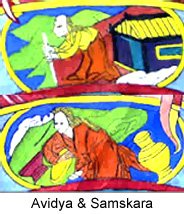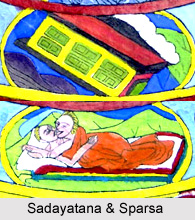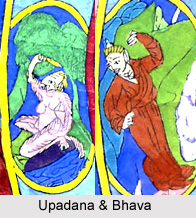 The Twelve Nidanas (from Pali nidana, meaning "cause, foundation, source or origin") are the most familiar application of the Buddhist concept of pratityasamutpada (dependent origination), identifying the roots of suffering to be in craving and ignorance. The Twelve Nid?nas are used in the study of phenomena according to the principle of Pratatyasamutpada. The objective of the Twelve Nidanas analysis is to unveil the origins of phenomena, and the `feedback loop` of conditioning and causation that results in suffering in current and future lives.
The Twelve Nidanas (from Pali nidana, meaning "cause, foundation, source or origin") are the most familiar application of the Buddhist concept of pratityasamutpada (dependent origination), identifying the roots of suffering to be in craving and ignorance. The Twelve Nid?nas are used in the study of phenomena according to the principle of Pratatyasamutpada. The objective of the Twelve Nidanas analysis is to unveil the origins of phenomena, and the `feedback loop` of conditioning and causation that results in suffering in current and future lives.
The fundamental principle of pratatyasamutpada and the Twelve Nidanas is to see the conditioned causal connection of each state that supports the next in the cycle of one`s life as one suffers in Samsara. It is explained thoroughly in the Visuddhimagga of Buddhaghosa, the central text of the Mahavira commentarial tradition.
 The causal chain of analysis utilised in this type of analysis appears to function from the position that individual phenomena are caused or conditioned by only a single cause. This reflects not an extensive declaration by the Buddha Sakyamuni (Gautama Buddha, sage of the Sakya clan) or the Theravada commentators that individual phenomena can have only a single cause, but rather a simplified assumption used to make the analytical technique more useful to the practitioner.
The causal chain of analysis utilised in this type of analysis appears to function from the position that individual phenomena are caused or conditioned by only a single cause. This reflects not an extensive declaration by the Buddha Sakyamuni (Gautama Buddha, sage of the Sakya clan) or the Theravada commentators that individual phenomena can have only a single cause, but rather a simplified assumption used to make the analytical technique more useful to the practitioner.
Like many of the techniques and theories incorporated in the Visuddhimagga and other commentarial works, the Twelve Nidana analysis was meant to be used as one of many techniques available to a student of meditation, and its form reflects both the requirements and experiences of Buddhist meditation practitioners.
The chain of twelve phenomena leading to future births and suffering was diversely presented by the Buddha; Buddhaghosa narrates four methods - working from `bottom to top`, working from the `middle to the top`, working from `top to bottom`, and working from the `middle to the source`. The first method starts with ignorance and goes on to illness, old age, and death. The second method starts with attachment and goes on to birth. The third method starts with birth and moves back to ignorance. The fourth method starts with attachment and goes on to ignorance.
The twelve nidanas are as follows:
• Avidya (Sanskrit) or Avijja (Pali); English "ignorance".
Avidya is ignorance of Four Noble Truths, Three marks of existence, Five Skandhas, Karma, and Pratatyasamutpada. This is the chief cause of dukkha (suffering dissatisfaction, pain, uneasiness, etc.)
 It is also ignoring the integrally open, spacious and fluid quality. Avidya is averting from the feeling of `big open space` because it feels menacing.
It is also ignoring the integrally open, spacious and fluid quality. Avidya is averting from the feeling of `big open space` because it feels menacing.
• Samskara (Sanskrit) or Sankhara (Pali); English "(mental) formations".
Samskara stands for Mental Formations and Volitional Will. It is also the Mental constructs, based on a non-existent "I" or "Self".
• Vijnana (Sanskrit) or Vinnna (Pli); English "(dualistic) consciousness".
Vijnana stands for thevVarious states of consciousness.
• Namarupa (Sanskrit and Pai); English "name and form".
Namarupa can be broken into N?ma, the naming activity of the discursive mind and R?pa its attendant form, without which mind cannot exist. It is also the developing of an internal representation of external objects.
• Sadayatana (Sanskrit) or Salayatana (Pali); English "six sense gates".
The six senses comprise eye-seeing, ear-hearing, nose-smelling, tongue-taste, skin-touch, mind-thought. Apart from the five senses which one is familiar with, in Buddhism, the sixth sense is the mind, and the object of mind is thought. Sadayatana refers distinctively to the six sense organs.

• Sparsa (Sanskrit) or Phassa (Pali); English "contact".
Sparsa stands for contact between the eye and tree, between the ear and drum, nose and perfume, tongue and salt, skin and cut, mind and thought.
• Vedana (Sanskrit and Pli); Eng. "sensation".
Sensation refers to the quality of feeling. One has to judge about it being pleasant, unpleasant or neutral.
• Trsna (Sanskrit) or Tanha (Pali); English "craving" or "desire" or "thirst".
Desire is sometimes distinguished as the cause of suffering - a constant dissatisfaction or annoyance.
One feels compelled by this feeling of desire, for instance, when thirst compels one to seek water.
• Upadana (Sanskrit and Pali); English "attachment".
Upadana is attachment of all kinds - to persons, to life, corporeal comfort, pleasant sensations, to unpleasant sensations also. There is also attachment to beliefs, thoughts, ideas/ideologies. Such a kind of strong attachmwent sometimes result in clashes, confrontations, fighting, or even wars).
Fixation - Man has formed a mental version of the object or event, and one fixates on that, choosing one`s own internal version over external reality.

• Bhava (Sanskrit and Pali), English "becoming".
Bhava is the steps or actions taken to recreate, that which was hungered or desired in step eight above Trsna.
The thirst/desire, in addition to one`s fixation, has now picked up momentum.
• Jati (Sanskrit and Pali); English "birth".
Jati stands for bearing fruit of the former ten steps. That which was desired and conditioned now comes to be.
• Jaramarana (Sanskrit and Pai); English "aging (old age), decay and death".
Jaramarana states that, that which is born, dies. All conditions, all experiences must come to an end.



















